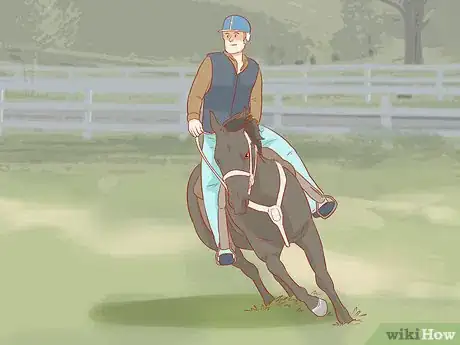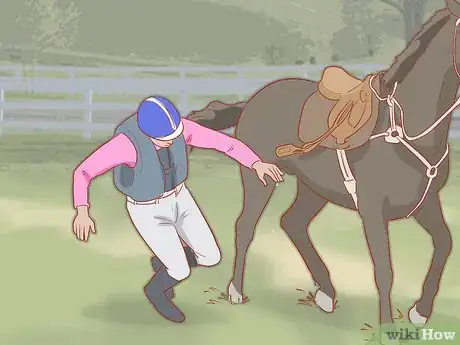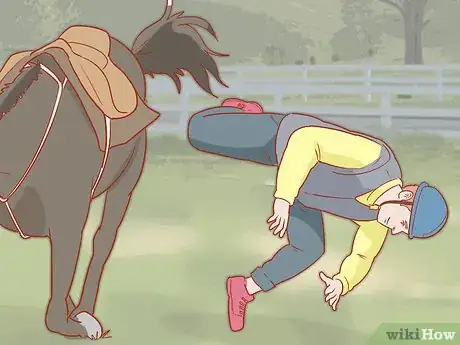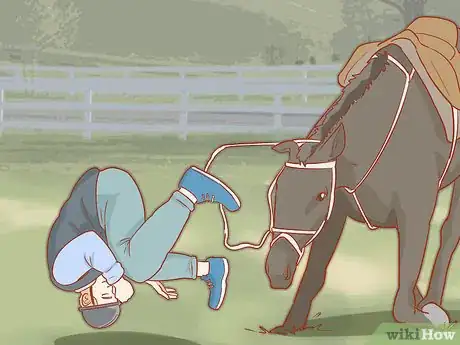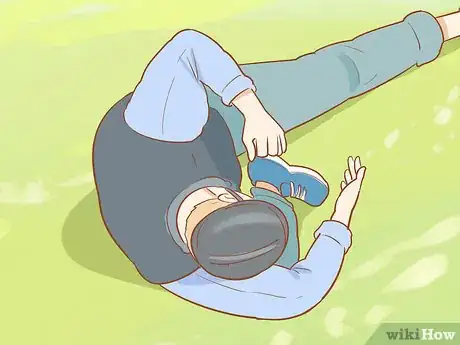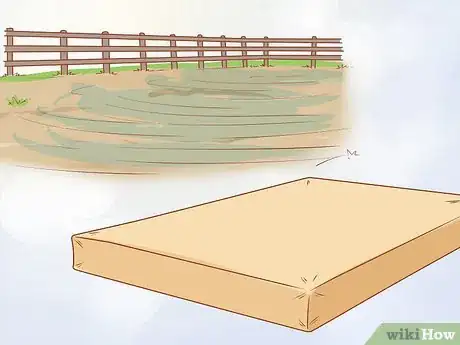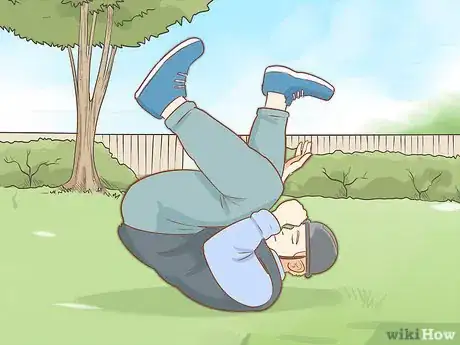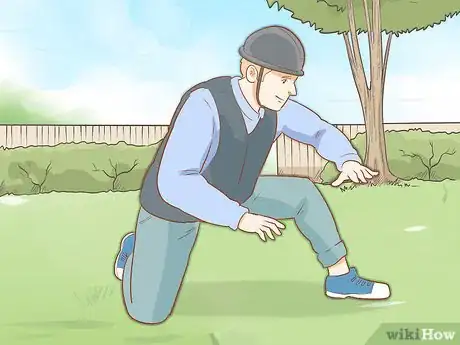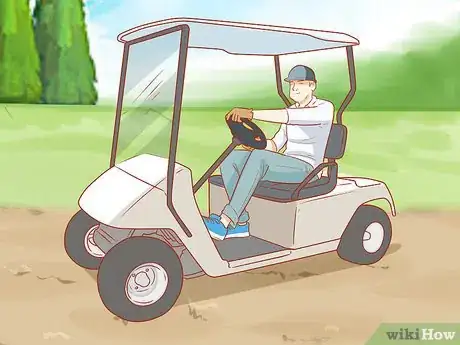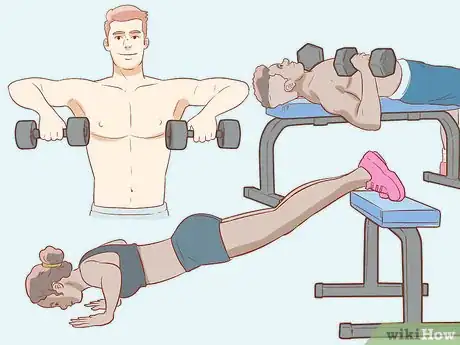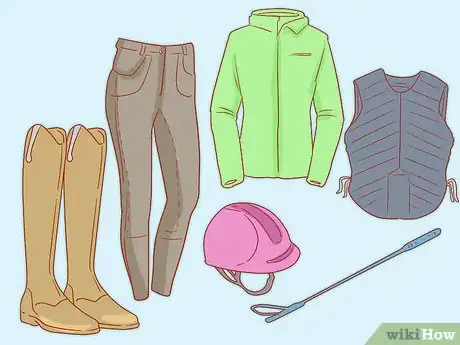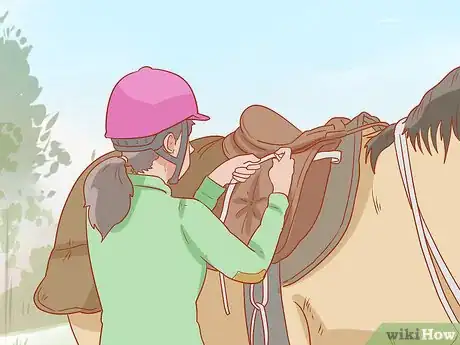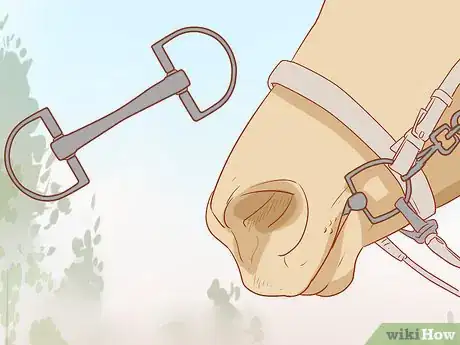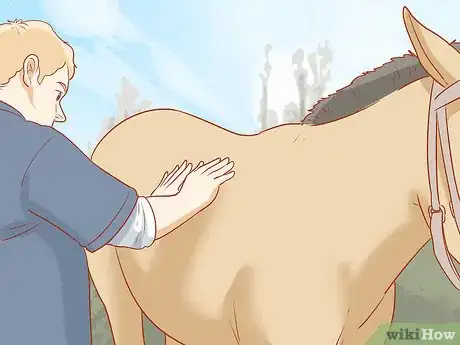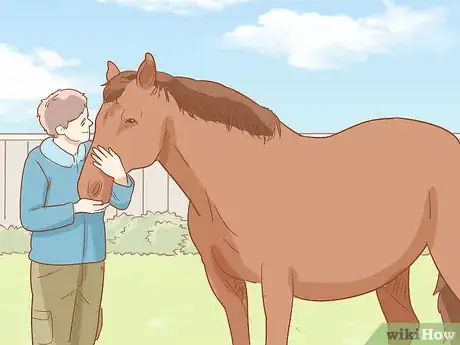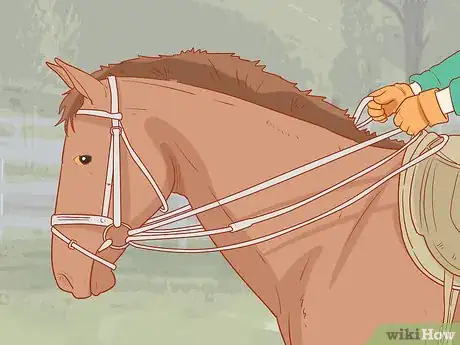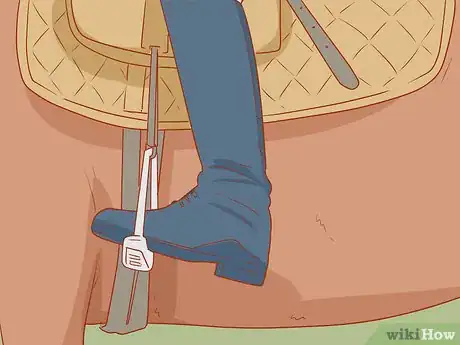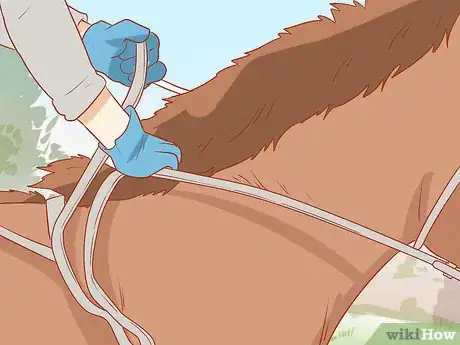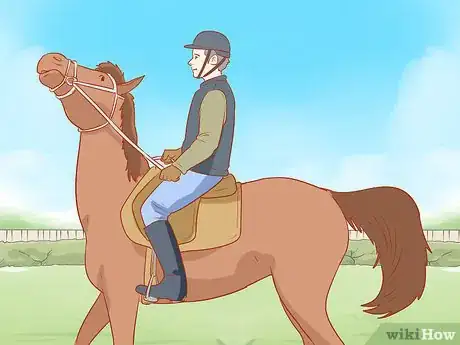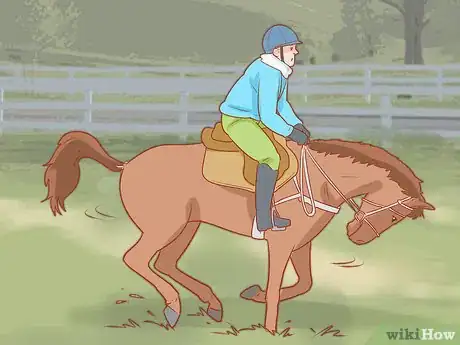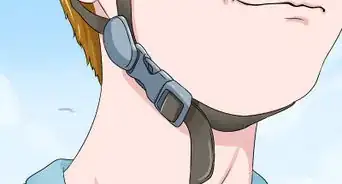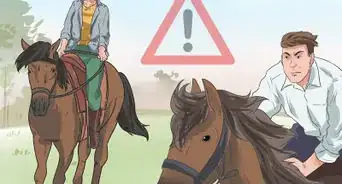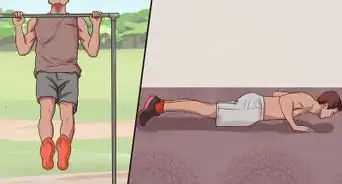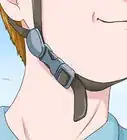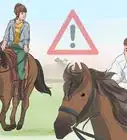This article was co-authored by wikiHow Staff. Our trained team of editors and researchers validate articles for accuracy and comprehensiveness. wikiHow's Content Management Team carefully monitors the work from our editorial staff to ensure that each article is backed by trusted research and meets our high quality standards.
There are 18 references cited in this article, which can be found at the bottom of the page.
wikiHow marks an article as reader-approved once it receives enough positive feedback. In this case, 88% of readers who voted found the article helpful, earning it our reader-approved status.
This article has been viewed 263,054 times.
Learn more...
Falling off a horse is almost inevitable if you ride often. Learning how to prevent falls and fall gracefully when it happens can help prevent serious injury, though there's nothing you can do to protect yourself completely. If you're worried about falling, talk to an experienced trainer or rider who can also give you some tricks to help with the issue.
Steps
Falling as Safely as Possible
-
1Decide to fall off when you need to. As a rider, your goal is to stay on the horse. However, at some point when you've run into trouble on your horse, you have to decide that you're falling and commit to it. If you feel like your horse is going down, you need to get off it. That means dropping the reins and preparing to tuck and roll so that you can fall safely.[1]
- As you decide you're going to fall, kick your feet out of the stirrups to start getting away from the horse.
- If you hold onto the reins as you fall, you may hurt your shoulder or be dragged along the ground.
-
2Push out away from the direction your horse is falling. If your horse is falling to one side or the other, move your body the opposite way. Use the place between the horse's shoulder blades to push off with your knuckles. Move upwards, and bring your knee and heel up on the side where the horse is going down. Pull your heel up to your rear if possible so that it doesn't go under the horse. When the horse gets to the ground, use your tuck and roll technique to move away from the horse.[2]
- Go as far and as fast as possible away from the horse.
Advertisement -
3Land on your feet if possible. Even though you're going to tuck and roll, your goal is to land as much on your feet as possible, then go forward into the roll. It's not always possible to go feet first but take the opportunity when you can.[3]
-
4Relax your muscles. Try to relax your body as you fall. Tensing up your muscles will severely limit your body's ability to absorb impact. It may take many falls to learn this habit, but you'll likely have less painful falls when you do.
-
5
-
6Take the brunt of the weight in the roll. As you tuck, try to roll onto the back of your shoulder, then your back. Keep rolling until you're back to your front again. You may need to roll again to get away from the horse.[6]
- If you don't land feet first, try to take the brunt of the fall on your thigh or the back of your shoulder. Do your best to avoid landing on your neck or straight on your back.[7]
Practicing Falling
-
1Work on flat ground first. You can work in the riding arena if you want, or if you prefer, you can work on a soft gym mat to break the fall. The key is to perfect your falling technique while on the ground, not on a horse.[8]
- By practicing a fall, you're getting it in your muscle memory. That way, when you start falling off a horse, you're more likely to fall safely.
-
2Stand with your feet shoulder-width apart. Wear a helmet and safety vest while practicing. Stand up tall, and then cross your arms across your chest. This is the starting position for your falling practice.[9]
- Your arms need to be tight across your chest so that you don't use an elbow to take the force of the fall, which could result in a broken elbow. Never put your arms straight out in front of you to catch your fall.[10]
- You may want to wear a protective vest to protect your torso while falling. You can find them at tack stores and online.[11]
-
3Go down on one knee and roll on your shoulder. When your knee hits the ground, start to tuck into yourself. Roll onto the back of the same shoulder as the knee that hit the ground so it takes the brunt of the fall. Bring your head and shoulders up as you roll, and you should hit the correct point on your shoulder.[12]
- As you roll, try to do so at an angle from where you began. That way, you end up moving away from your horse.
-
4
-
5Keep rolling until you hit your knees and feet again. Use the force you've created to roll back onto your front. You should end up on your knees, and you can use the momentum to get back on your feet.[15]
- Practice this move over and over until you get the hang of it. Think of it sort of like a forward roll, except you move more at an angle.
-
6Work on the same movement off of a low vehicle like a golf cart. Have the driver go at a slow pace. Watch the ground and make the jump, bending your knees as you land. Tuck and roll like you practiced from a standstill until you are on your feet again.[16]
- Practice this move until you're comfortable with it.
Protecting Yourself before You Ride
-
1Exercise most days of the week to get in good shape. While it takes time to get in good shape, the more fit you are, the better you'll be able to react in case of a fall. Plus, it reduces your injury risk and helps you heal faster if you do get injured.[17]
-
2Wear a riding helmet every time you're on a horse. A riding helmet can make the difference between a slight headache and a severe concussion. Make sure the helmet fits correctly before you mount, meaning it's not too loose or too tight. Ideally, have it checked professionally when you buy it and return it periodically to have it re-padded.[18]
- Choose a riding helmet certified by a safety organization. Look for helmets that state they meet ASTM/SEI standards.
- Don't use a bike riding helmet instead of a riding helmet. Bike helmets don't offer the same protection as riding helmets.
-
3Choose safe riding clothes. Opt for zippered riding boots fit well and are sturdy with a low heel. Any clothing you wear should be comfortable and allow you to move easily. However, don't wear anything that is too loose, as it can tangle with the reins and other parts of the saddle.[19]
- Other types of shoes and tie up riding boots can get trapped in the stirrups, which can drag you along in the case of a fall. Plus, sturdy boots help protect your foot if the horse stamps on it.[20]
-
4Check that the tack is comfortable for the horse. The horse could be uncomfortable or in pain if the saddle does not fit properly or if it is too far back or forward. If the horse is uncomfortable, it may misbehave by bolting, rearing, or bucking in order to escape the painful tack. Making painful tack more comfortable is an often overlooked way of resolving many behavioral issues.
- For instance, make sure the saddle isn't too far forward, causing it to hit the horse's shoulder blades as it walks. That makes the saddle uncomfortable for the horse.
- Check the bottom of the saddle before putting it on your horse to make sure it doesn't have any broken or rough spots that could be hurting your horse.
- Add a thick, wool saddle pad underneath the saddle to make it the most comfortable for your horse.[21]
-
5Ride using a "soft" bit rather than a harsh bit. In other words, don't make the bit too tight. When the bit fits correctly, you should see a single wrinkle in the corner of the horse's mouth right above the bit. Look for a relaxed head and mouth to tell if the horse is happy. If it's not, it will toss its head and move its mouth around on the bit a lot.[22]
- Harsher bits make the horse more sensitive, but that can actually make the horse harder to control, as the horse will over-respond to your commands. Plus, a painful bit can even cause a horse to bolt.
-
6Use safety stirrups and non-slip stirrup pads. Safety stirrups come in various designs, but all are meant to prevent your foot from becoming trapped in case of a fall. Some even break away from the saddle to help prevent your legs from being trapped.[23]
- Even with safety stirrups, make sure you keep your heels down. It's better to be safe than sorry.
-
7Check for signs of pain. If your horse is acting up or displaying unusual behavior, take some time to examine it. Rub your hand all over your horse's body. If he shows signs of pain anywhere, have your vet check it. If your horse continues the unexplained behavior, ask for help from an experienced rider.
Reducing Risk while Riding
-
1Ask for a gentle, older horse if you're inexperienced. Don't try to ride the spirited horse if you haven't had much experience. In addition, work under the direction of a guide or instructor if you haven't ridden before, as you need to learn the ins and outs of riding.[24]
-
2Stay with the herd when riding in a group. Horses like to be near other horses, and shy or timid horses can get upset if you lead them away from the group. Stick with the group, and your horse will be happier.[25]
- Moving away from the group can cause your horse to buck or become upset.
- However, try not to ride too close together, as that can cause a horse to kick. Often, this happens when you get behind when you're riding with a group and your horse suddenly wants to catch up. It may panic a bit and rush headlong into the group, causing mayhem and possibly kicking.
-
3Maintain your balance. This skill is essential in all horse riding, and it will help keep you safe when the horse spooks or attempts a difficult maneuver. Push your shoulders back so you're sitting up straight and make sure your shoulders are perpendicular to your toes. Maintain even weight on each foot in your stirrups, except when intentionally putting weight on them.
- Always return to this position, even if you need to move around to make a jump or another maneuver.
- Never bounce around in the saddle intentionally. Not only could this cause you to lose your balance, this may make the horse rear, buck, or increase speed suddenly.
-
4Use the reins appropriately. Never jerk on your reins with more force than necessary. A sudden pull may surprise the horse and cause dangerous behavior. Instead, always use steady and gentle pressure when pulling on the reins.
-
5Keep your feet in a safe position. When in the saddle, push your heels down and keep your stirrups on the ball of your foot. In this position, you can easily slip your feet out of the stirrups. Slip your feet out quickly if the horse starts bucking or acting dangerously to avoid catching your feet and being dragged behind the horse.[26]
-
6Go slowly on rough terrain. Slow down in areas without a trail. Unknown hazards could cause your horse to fall, bringing you down with it. If you're not sure about the area, rein in your horse to slow down.[27]
- Keep in mind that horses like to race, so be wary of letting your horse go too fast. If your horse is abreast of other horses, it may try to go faster and faster, particularly if it knows its headed towards home. Slow it down to keep things from getting out of control.
-
7Keep control of the horse. If the horse isn't listening to you, you will have a harder time controlling him when he spooks. If you suspect the horse isn't paying attention, try "sponging" the reins by squeezing them in alternate hands. The bit will wiggle slightly, and alert the horse to pay attention.
- Stop if necessary. If your horse gets nervous when another horse passes by, when a plastic bag drifts by, or for any other reason, stop the horse. Let another rider know what's going on and attempt to calm the horse before moving.
-
8Pull the horse's head to the side to prevent it from rearing. If you react quickly, you can prevent the horse from rearing. As soon as it starts to spook, pull the head to one side with a rein and push the hindquarters out to the other side by throwing your weight the other way. Now the horse's weight will be on its forequarters, disengaging its ability to push off its hindquarters and rear.
- Never pull down and back. This can cause you or the horse to flip over.
-
9Try to stay on a bolting horse. If you lose control of the horse, do your best to stay with the horse's motion and to gradually slow and calm your mount. Most horses will eventually slow down and stop, even if they've been running wild. Hold on mostly with your thighs, using your own balance to stay with the horse's motion.[28]
- Holding on with your calves can cue the horse to increase its speed.
- If there's no way you can stay on the horse, start planning to jump and roll.
Community Q&A
-
QuestionI'm fairly new to riding, and I just recently fell off, but I got back on. Now I'm scared for my next lesson, I don't want to be thrown off again. Any tips?
 Community AnswerFalling off can be scary, but it shouldn't stop you getting on again. Make sure to always wear a helmet and try not to break your fall with your arms! Every rider falls off, and in the end it will help you become a better rider.
Community AnswerFalling off can be scary, but it shouldn't stop you getting on again. Make sure to always wear a helmet and try not to break your fall with your arms! Every rider falls off, and in the end it will help you become a better rider. -
QuestionAfter saddling & talking calmly, I mounted the horse while it stood along side the fence. Unfortunately, my cousin aaid the 'bucking strap' should be fastened & pulled t tight. The horse threw me in 5sec
 Community AnswerWalk your horse around the area until it is relaxed, with it's head and ears relaxed. This may take a while, but it will definitely help. If you notice that something is loose, stop the horse, get off, and bring your horse away from the mounting block if they are feeling skittish. Then you can tighten anything that is loose, and if the horse is nervous, walk them around a little more.
Community AnswerWalk your horse around the area until it is relaxed, with it's head and ears relaxed. This may take a while, but it will definitely help. If you notice that something is loose, stop the horse, get off, and bring your horse away from the mounting block if they are feeling skittish. Then you can tighten anything that is loose, and if the horse is nervous, walk them around a little more. -
QuestionHow can I stay safe and secure while my horse is going over the jump?
 Community AnswerMake sure your heels are down, have a helmet on, and practice balance a lot beforehand.
Community AnswerMake sure your heels are down, have a helmet on, and practice balance a lot beforehand.
Warnings
- Check the weather before you ride. Cancel the ride if it looks like there will be a storm, severe rain, or reduced visibility.⧼thumbs_response⧽
- A serious impact will ruin your helmet, even if it looks fine. Many helmet companies will replace your helmet for free.⧼thumbs_response⧽
- Never ride alone or at night. It's safer to ride with supervision.⧼thumbs_response⧽
- Keep an eye out for holes as you ride to avoid tripping.⧼thumbs_response⧽
- Avoid riding on a road, as you and your horse could be hit by a car.⧼thumbs_response⧽
- If you're a kid, never ride without adult supervision. Riding without adult supervision is a good way for accidents to happen.⧼thumbs_response⧽
References
- ↑ https://practicalhorsemanmag.com/training/horseback-riding-falls-jim-wofford-27838
- ↑ https://practicalhorsemanmag.com/training/horseback-riding-falls-jim-wofford-27838
- ↑ https://www.equitours.com/views-from-the-saddle/article/riding-safety-tips-to-keep-you-safe-and-sound-on-the-trail/
- ↑ https://practicalhorsemanmag.com/training/horseback-riding-falls-jim-wofford-27838
- ↑ https://www.horseandhound.co.uk/videos/how-to-videos/video-how-to-fall-off-a-horse-safely
- ↑ https://practicalhorsemanmag.com/training/horseback-riding-falls-jim-wofford-27838
- ↑ https://www.equitours.com/views-from-the-saddle/article/riding-safety-tips-to-keep-you-safe-and-sound-on-the-trail/
- ↑ https://www.horseandhound.co.uk/videos/how-to-videos/video-how-to-fall-off-a-horse-safely
- ↑ https://practicalhorsemanmag.com/training/horseback-riding-falls-jim-wofford-27838
- ↑ https://www.horseandhound.co.uk/videos/how-to-videos/video-how-to-fall-off-a-horse-safely
- ↑ https://www.equitours.com/views-from-the-saddle/article/riding-safety-tips-to-keep-you-safe-and-sound-on-the-trail/
- ↑ https://practicalhorsemanmag.com/training/horseback-riding-falls-jim-wofford-27838
- ↑ https://practicalhorsemanmag.com/training/horseback-riding-falls-jim-wofford-27838
- ↑ https://www.horseandhound.co.uk/videos/how-to-videos/video-how-to-fall-off-a-horse-safely
- ↑ https://practicalhorsemanmag.com/training/horseback-riding-falls-jim-wofford-27838
- ↑ https://practicalhorsemanmag.com/training/horseback-riding-falls-jim-wofford-27838
- ↑ https://practicalhorsemanmag.com/training/horseback-riding-falls-jim-wofford-27838
- ↑ https://orthoinfo.aaos.org/en/staying-healthy/horseback-riding-injury-prevention
- ↑ https://orthoinfo.aaos.org/en/staying-healthy/horseback-riding-injury-prevention
- ↑ https://kidshealth.schn.health.nsw.gov.au/horseriding
- ↑ https://horseandrider.com/gear/horse-tack-check-with-lynn-palm
- ↑ https://horseandrider.com/gear/horse-tack-check-with-lynn-palm
- ↑ http://www.specialolympicsga.org/wp-content/uploads/2011/05/new-information-regarding-safety-stirrups-2.pdf
- ↑ https://kidshealth.schn.health.nsw.gov.au/horseriding
- ↑ https://www.equitours.com/views-from-the-saddle/article/riding-safety-tips-to-keep-you-safe-and-sound-on-the-trail/
- ↑ https://www.equitours.com/views-from-the-saddle/article/riding-safety-tips-to-keep-you-safe-and-sound-on-the-trail/
- ↑ https://www.equitours.com/views-from-the-saddle/article/riding-safety-tips-to-keep-you-safe-and-sound-on-the-trail/
- ↑ https://www.equitours.com/views-from-the-saddle/article/riding-safety-tips-to-keep-you-safe-and-sound-on-the-trail/
About This Article
To avoid injuries while falling off of a horse, be sure to drop the reins when you start to fall and push your body out away from your horse. Next, relax your muscles as much as possible and pull in your limbs so that you're in a tucked position. Then, try to land with your feet first, but if that's not possible, stay tucked and roll onto the back of your shoulder. Remember to roll away from the horse and keep rolling until you're right side up. For tips on practicing falls, read on!
